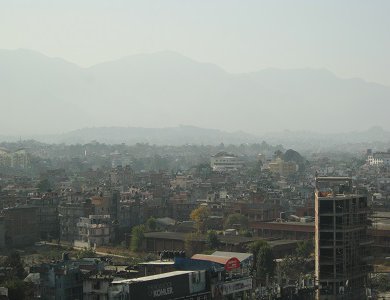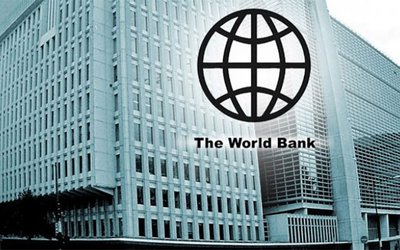
Along with haphazard building constructions, Nepal’s telecom companies are installing big towers over the roofs of houses in Kathmandu Valley, irrespective of the safety standards adopted in terms of the size and strength of the buildings.
Similarly, Nepal Electricity Authority is yet to take any safety measures in installing its electricity transformers in various parts of Kathmandu Valley. Almost all transformers are likely to fall if a major quake shakes the valley.
The construction of buildings continues even as enforcement of the building codes is very weak in Nepal. Although Kathmandu Metropolitan City introduced the building code a few years back, its full implementation is far from realized.
“Kathmandu Metropolitan City is now strictly enforcing the building code,” said Laxman Aryal, its chief. Given the present situation, there will be a heavy damage in case an earthquake measuring over 8 in the Richter scale or something equivalent to the great earthquake like of 1934.
General secretary of National Society for Earthquake Technology-Nepal (NSET) Amod Mani Dixit holds the view that a major earthquake will be devastating for the valley. “Despite making certain improvements in safety against earthquakes, Kathmandu valley’s more than 60 percent houses will be destroyed in case of a major quake. There will be over 100,000 death and 300,000 injuries,” said Dixit (see interview).
According to the seismologists, a major earthquake is due in the fault line lying between Kathmandu of Nepal and Shimla of India. Studies have shown that Nepal has no record of a major earthquake in the span of 80 years. As there was no major quake since 1934, the threat is looming large.
Along with earthquakes, landslides, floods and other calamities are creating a havoc annually, making Nepal a disaster prone country. Earthquakes are not as frequent, but they have the potential for causing the greatest damage.
As a country in the high risk seismic zone, earthquakes are very likely in Nepal. Past records have shown that Nepal can expect two earthquakes of magnitude anywhere between 7.5 and 8 on the Richter scale every forty years and one earthquake of magnitude of 8+ in Richter scale every eighty years.
The last great earthquake to strike Nepal was in 1934. It had a magnitude of 8.3 on the Richter scale. It caused a considerable damage to buildings and a great loss of lives. Since then, the population of Kathmandu Valley has gone up. Urban development and inadequately planned construction practices have deteriorated the situation further. As Nepal is celebrating the Earthquake Day on January 16, to remember the loss from the great earthquake of 1934, no body needs to predict that such disasters would cause a greater loss of lives and properties now.
Haphazard construction of buildings and other infrastructures has created further problems. Although Nepal lies in an earthquake prone zone, there is yet to dawn enough realization about the safety measures at official level also. Towers built by Telephone companies and Nepal’s electricity offices are two examples of their inattention to the knowledge on disaster. Despite availability of technology to make safe homes, an overwhelming number of people are yet to perceive the real threat.
Earthquakes are inevitable in a regular process of time. According to Seismological Center, more than 500 small and big shocks occur annually. Scientists, government officials and the public can all help to make societies more resilient to earthquakes and other natural hazards by way of some prudent actions. But, despite several efforts, the lack coordination among the authorities is starkly visible at times of disaster.
Some have predicted that the level of Haiti’s Quake may completely ruin Kathmandu, cutting it from outside world. Deadly earthquakes often occur on fault lines at any time. Nepal is no an exception in terms of its location. Unless it prepares for earthquakes, developing a broad set of tools to make communities resilient, the risks will grow bigger.
The main problem with Nepal is imparting knowledge to the common people. “Scientists must assess and effectively communicate their knowledge about earthquakes. Public officials must admit their mistakes and learn from them,” said an expert.
The public are generally poor judges of their own safety. They think they are safe until a disaster occurs. More public awareness of the need to prepare for disasters is needed. There is the need to make annual earthquake drills to sensitize the people.
Following the earthquake of 1988, seismology related technology has improved in Nepal and certain precautionary methods have also been taken. The government has disaster contingency plans and programs.
With support from development partners, Nepal has already formulated a number of programs. But problems may remain over the quality of data and research. “We need to improve the research and quality of data to prepare for Disaster Risk Reduction.
In the wake of a series of large earthquakes, the country's scientists are debating how technology might help limit the devastation caused by future disasters.
Although the scientists have been used technology to successfully identify the direction of movement and major cracks in faults in different parts of world, Nepal is yet to build its own capacity to get this routine information.
Academic research was being hampered by a lack of seismic technologies. Productive research in this area needs old and new seismic data but, unfortunately, Nepal’s old seismic data is either not reliable or of poor quality.
The need to speed up work on a reliable system for predicting potential aftershocks in the days following a strong earthquake has become more urgent
A report has showed the number of earthquakes worldwide of more than [magnitude 5.5] increasing by some factor.
History of Earthquakes
Not many people in Nepal realize that Nepal is among the high risk countries in terms of earthquake occurrences. On the other hand, there is the need to find out more about the reason behind this and what the damages might be if Nepal is hit with a devastating earthquake.
The first recorded earthquake in history of Nepal took place on June 7, 1255 AD. According to records, one third of the total population of Kathmandu were killed, including Abahya Malla, the King of Kathmandu valley. Numerous buildings and temples of the valley were entirely destroyed while many of them were severely damaged. The magnitude of the earthquake is said to be around 7.7 on the Richter scale.
Around 1316 BS/ 1260 AD, the next recorded big earthquake occurred during the reign of King Jayadev Malla. Many buildings and temples collapsed and many more were severely damaged. Although the exact number of fatalities cannot be confirmed, we know from the facts that there was a heavy loss of lives resulting from the earthquakes and from the subsequent epidemic and famine said to be widespread which arose in the aftermath of the disaster.
In 1408, another major earthquake hit Kathmandu in the month of August/ September. The temple of Rato Matchendranath was completely destroyed while many other temples and buildings collapsed and were damaged. Cracks on land appeared in many places.
The 1681 AD’s earthquake was another major quake that occurred during the reign King Sri Niwas Malla. Although very little information is available on this particular earthquake, there was a heavy loss of lives as well as many buildings, including temples, that were either damaged or destroyed.
In months of June and July of 1767 AD, another significant earthquake seemed to have hit Nepal. Twenty one shocks and aftershocks of this particular earthquake is said to have occurred in a span of twenty four hours. During the reign of King Girban Yudha Bikram Shah, in the months of May or June, twenty one shocks of earthquakes in total were felt in Nepal in 1810 AD. In 1823, another earthquake hit Kathmandu Valley causing a heavy loss of life and property. Similarly, in 1883, two major earthquakes struck Kathmandu Valley. According to records, houses, temples, and public shelters collapsed. The tower of Dharahara was also severely damaged.
Four major earthquakes were felt in the months of June and July of 1834 AD. These earthquakes destroyed or damaged many buildings and temples. However, the extent of damage was much less than the previous ones (i.e., 1833 event).
In 1934 January, a major earthquake, Known as the Great Nepal-Bihar Earthquake struck the Kingdom of Nepal and its surrounding areas. The magnitude of the earthquake was 8.4 on the Richter scale. Casualty figures were the highest for any recorded earthquake in the history of Nepal. In total, 8,519 people lost their lives in Nepal. A total of 126,355 houses were severely damaged. Some 80,893 buildings were completely destroyed.
Disaster Risk Reduction
Although Nepal has been struck by several earthquakes in the past, the history of Nepal’s earthquake Risk Mitigation and Management is comparatively new. People were unaware about disaster risk management and only recently the government has started some measures in light of the new developments.
After the Udaypur earthquake of 1998, Nepal woke up to the risk of such disasters. It killed over 721 people, affecting life in 22 districts. Nepal has made several efforts since then, but they are still inadequate. Nepal has started the building code and disaster resilience management efforts, but the job is still too short. Instead of focusing on prevention, Nepal’s disaster management relies on rescue and rehabilitation. The earthquake of 2011 has shown that relief and rehabilitation alone is not enough. What is required is a preventive method based on the involvement of the community.
With the establishment of NSET, a non-governmental organization, in 1993, Nepal has made several studies and campaigns against the earthquake. Community awareness programs were launched nationwide.
In 1998 Nepal, government declared 16 January as the National Earthquake Safety Day (ESD). NSET launched the School Earthquake Safety Program (SESP) in 1999. All these helped to enhance the capability of the country.
Since the realization of the effects of earthquake on the population, various international non-governmental organizations have also been working in the area. Save the Children Fund, World Vision International Nepal and Practical Action have already initiated a number of program targeting schools. Similarly, UNDP has also supported several programs and projects.
All these efforts are laudable but little compared with the risks. Kathmandu Valley is still vulnerable and a major earthquake like that of 1934 will destroy it badly.
As Nepal sits across the boundary between India and southern Tibet and the two tectonic plates are still moving towards each other by 2 meters per century, this movement creates pressure within the Earth, which builds up and can only be released through earthquakes. This is how earthquakes can happen in Nepal.
Based on the seismic records of the number of earthquakes that occurred since 1255, earthquakes of magnitude greater than 8 occurred on average once every 80 years. The last great earthquake of magnitude 8.3 occurred in 1934.
As Kathmandu Valley is located on the site of a prehistoric lake which has been filled with soft sediments that make up the valley floor, there will be more damage here due to quake than in many other places. The population in the Kathmandu Valley has significantly increased in the recent times.
As the population of Kathmadu valley is over 5 million and it is increasing at a high rate, the looming earthquake is likely to be devastating for the people and their life and property. January 16 should remind us how we should work to stay safe.

Keshab Poudel
Poudel is the editor of New Spotlight Magazine.
- FM Dr. Deuba’s India Visit: Mission Aborted
- Mar 26, 2025
- AMBASSADOR MAEDA TORU: Warm Regards
- Mar 24, 2025
- PRO-MONARCHY MOVEMENT: Rising Dissatisfaction
- Mar 23, 2025
- Dr. PRABIN MANANDHAR: Person With Humility
- Mar 16, 2025
- US SUSPESION OF GRANT: Impact On Nepal
- Mar 10, 2025















